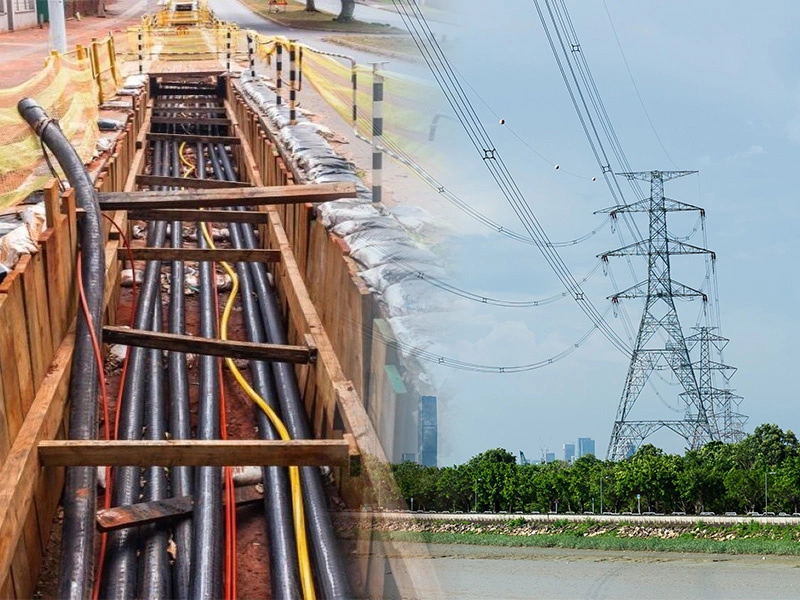In modern power transmission and distribution systems, choosing between underground cables and overhead cables (also known as aerial cables) is a critical decision that directly affects operational efficiency, investment costs and the safety of the entire project.
Conducting a comparison of underground cables and overhead cables will help you understand:
- The detailed structure of underground cables and overhead cables
- Detailed comparison of construction processes, durability, heat dissipation efficiency, and operating costs
- How to select the appropriate underground or overhead cables for your project or construction work
Through this, electrical engineering students and those interested in this field will gain an objective and comprehensive perspective to make the most suitable selection decisions for each specific project.
1. What is underground cable? What is overhead cable (overhead power line)
Underground cable is a type of electrical cable installed beneath the ground surface or in underground structures such as trenches, conduits, or tunnels. It is protected by special outer sheaths designed to provide moisture resistance and protection against mechanical impacts.
In contrast, overhead cable (aerial cable) is suspended on electrical poles, exposed directly to the external environment. The cable is designed to withstand harsh weather conditions including rain, wind, UV radiation, and temperature fluctuations.
Each cable type has its own advantages and limitations. Therefore, comparing underground cables and overhead cables will help you evaluate specific conditions regarding terrain, environment, technical requirements, and financial capability.
2. Structure of underground cables and overhead cables
2.1. Underground cable
Underground cable has a more complex structure than overhead cable because it must withstand harsh conditions beneath the ground. The typical structure of underground cable includes:
- Conductor: Usually made of copper or aluminum, with cross-sectional areas ranging from 10mm² to 300mm².
- Insulation: Uses XLPE (cross-linked polyethylene) or PVC material, with substantial thickness to withstand high voltage and moisture conditions.
- Inner sheath: Typically PVC, protecting the insulation layer and providing mechanical strength.
- Metallic armour: Usually consists of double steel tape armoured (DSTA), double aluminium tape armoured (DATA), or steel wire armoured (SWA), protecting the cable from external mechanical impacts such as excavation and collisions.
- Outer sheath: Made of PVC, providing moisture resistance, protection against termites, and chemical resistance in soil.
For more details about underground cable types, you can refer to the article here for a more comprehensive overview.
2.2. Overhead cable
Overhead cable has a simpler structure. It can be either insulated wire or bare conductor, focusing on tensile strength, load-bearing capacity when suspended overhead, and weather resistance. The cable structure typically includes:
- Conductor: Made of copper, aluminum, aluminum conductor steel reinforced (ACSR), or aluminum alloy. It is usually designed with a stranded structure to increase tensile strength, load-bearing capacity when suspended, and resistance to wind-induced vibration.
- Insulation: Uses XLPE or PVC.
- Outer sheath: Typically uses PVC, protecting the insulation layer from mechanical impacts, UV radiation, and other harmful agents.
3. Comparison of underground cables and overhead cables
3.1. Comparison of installation, construction, maintenance, and repair
The construction process, maintenance, and repair are two critical factors that directly affect costs, implementation time, and operational efficiency of cable systems.
The table below provides a detailed comparison of the key differences between underground cables and overhead cables:
| Criteria | Underground cable | Overhead cable |
|---|---|---|
| Construction process | Complex, expensive, requires advanced technical skills | Simpler, faster |
| Construction cost | High (excavation and road restoration are costly, especially in urban areas) | 40-60% lower than underground cable |
| Construction time | Long, affects traffic | Fast (can be completed within a few days, minimal impact on traffic and underground activities) |
| Construction challenges | Requires coordination with multiple infrastructure management units; risk of damaging existing underground structures; high technical requirements for cable jointing; difficult to install across rivers, canals, and complex terrain | Fewer challenges; easier to install in hilly, mountainous, and forested terrain |
| Fault detection | Difficult, requires specialized equipment such as partial discharge detectors or fault locators | Easy visual observation |
| Repair | Complex, expensive (requires excavation, professional technicians if cable terminations or joints are damaged) | Quick, simple (only requires lifting equipment or pole climbing); low cost |
| Maintenance frequency | Low (well-protected underground) | Higher (directly exposed to weather and environmental factors) |
3.2. Comparison of safety, reliability, and environmental impact
Underground cables are highly rated for safety. However, they also present certain risks compared to overhead cables
| Criteria | Underground cable | Overhead cable |
|---|---|---|
| Public safety | High (no direct contact with people and animals) | Lower (high risk of electrical contact if cable falls, breaks, or insulation fails) |
| Natural disaster resistance | Not affected by storms, floods, fallen trees, or lightning strikes | Easily affected by storms, floods, fallen trees, and lightning |
| Fire and explosion risk | Low (minimizes widespread fire and explosion) | Higher (risk of spreading during incidents) |
| Incident risks | Difficult to extinguish fires in cable trenches, risk of accidental cutting during other construction work, moisture ingress during prolonged flooding | Dangerous for tall vehicles (container trucks, cranes), affects urban landscape |
| Environmental impact | Minimal exposure to UV radiation, storms, acid rain; stable temperature | Directly exposed to UV radiation, extreme temperature fluctuations, rain, wind |
| Damage risk | Corrosion from moisture, soil chemicals, termites, rodents | Rapid aging of outer sheath due to UV radiation, breakage from vibration, storms, fallen trees, collisions |
3.3. Transmission efficiency and heat dissipation
Heat dissipation capability is a crucial factor that determines power transmission efficiency, current carrying capacity, and the lifespan of cable systems. The differences in installation environments create distinct advantages and disadvantages between underground and overhead cables.
| Criteria | Underground cable | Overhead cable |
|---|---|---|
| Heat dissipation environment | Through surrounding soil, limited heat dissipation | Through air, cooled by natural wind |
| Yếu tố ảnh hưởng | Soil moisture (dry soil conducts heat less effectively than moist soil), heat accumulation when multiple cables are placed close together | Natural wind, minimal impact from heat accumulation from adjacent cables |
| Current carrying capacity | Comparable to overhead cable | Comparable to underground cable, however can transmit higher voltages than underground cable |
| Power loss | Higher due to elevated temperature increasing resistance | Lower (lower temperature helps reduce resistance) |
| Temperature stability | High (stable soil temperature, minimal seasonal variation); easier to predict and control current carrying capacity | Lower (affected by sudden weather changes) |
| Thermal overload risk | Higher due to limited heat dissipation | Lower under harsh operating conditions |
3.4. Comparison of investment and operating costs
Cost is one of the critical deciding factors when choosing between underground and overhead cables. The table below provides a detailed analysis of the investment and operating cost structure for both cable types
| Cost category | Underground cable | Overhead cable |
|---|---|---|
| Initial investment cost | ||
| Cable materials | Higher | Lower |
| Installation construction | Very high (excavation, backfilling) | Low (poles + cable stringing) |
| Auxiliary equipment | Expensive (trenches, covers, warning signs) | Inexpensive (insulators, clamps, guy wires) |
| Total investment | 100% (benchmark) | 40-60% |
| Operating cost | ||
| Periodic maintenance | Low (minimal failures) | Higher (frequent inspections) |
| Repair when damaged | Very high (excavation) | Low (easy access) |
| Power loss | Slightly higher | Lower (better heat dissipation) |
Selection based on financial capability:
- Projects with limited budgets requiring rapid deployment → prioritize overhead cable
- Long-term projects with substantial initial capital → consider underground cable
- Areas with high land value and important landscapes → underground cable is prioritized despite higher costs
4. Should you choose underground cable or overhead cable? (Practical applications)
4.1 Applications
Underground cable is prioritized in the following cases:
- Urban areas and city centers:
- Areas with high population density requiring absolute safety
- Areas with important urban landscapes where exposed electrical wires would compromise aesthetics
- Historic streets, tourist areas, high-end commercial districts
- Industrial areas and special projects:
- Factories and facilities with high safety requirements
- Airports, seaports, hospitals, data centers
- Areas with equipment sensitive to electromagnetic interference
- Special terrain:
- Coastal areas and islands (avoiding corrosion from salty air)
- Areas with frequent storms
- Across rivers, canals, waterways (submarine cables)
Overhead cable is suitable for:
- Rural areas and remote regions:
- Low population density, low investment requirements
- Long transmission lines, complex hilly and mountainous terrain
- Areas difficult to access for underground cable installation
- General residential areas:
- Developing residential areas
- Areas with moderate construction density
- Locations requiring rapid deployment with limited budgets
- Long-Distance transmission lines:
- Lines connecting transformer substations
- Forested and mountainous areas, vast plains
4.2. Selection guidelines
To select the appropriate cable type, it is necessary to consider technical, economic, and environmental factors comprehensively. Below are important criteria to consider:
Based on technical requirements:
- High voltage (≥35kV) and short distance (<2km): prioritize underground cable
- Medium voltage, low voltage, long distance: overhead cable is more economical
- High reliability requirements, minimal maintenance: underground cable
Based on environment:
- Crowded urban areas, important landscapes: underground cable
- Rural areas, remote regions, difficult terrain: overhead cable
- Coastal areas with storms: careful consideration, prioritize underground cable if conditions permit
Based on cost:
- Limited budget, requiring rapid deployment: overhead cable
- Long-term investment, substantial capital: underground cable
5. Frequently asked questions (FAQs)
5.1. Can both types of cables be used in the same system?
Absolutely, and this is a widely adopted solution in practice. Power distribution systems typically combine underground cables in urban areas and population centers, transitioning to overhead cables in suburban and rural regions. When combining both types, it is essential to ensure technical requirements at transition points, including appropriate cable joints, lightning protection systems, and standardized cable termination boxes.
5.2. Which cable type is safer for residential areas?
Underground cable is significantly safer for residential areas because it eliminates the risk of direct electrical contact, remains unaffected by weather conditions, and minimizes risks from fallen trees and vehicle collisions. However, underground cables must also be clearly marked to prevent accidental cutting during other construction activities.
5.3. Which has a longer lifespan - underground cable or overhead cable?
Overhead cable may have high mechanical lifespan, particularly for the load-bearing components, but the insulation and protective sheath lifespan can be affected more rapidly compared to underground cable.
Underground cable generally has a longer overall lifespan (for both conductor and insulation components) because it is better protected from harsh environmental impacts.
The maintenance practices and installation and operating conditions will determine the actual lifespan of both cable types.
6. Conclusion: Comparing the advantages and disadvantages of underground and overhead cables
Through this comparison of underground cables and overhead cables, there is no absolute answer as to which type is better, but rather which type is more suitable for each specific project.
Underground cable is the preferred choice when high safety requirements, long lifespan, and urban aesthetics are priorities. This is the appropriate choice for urban areas, industrial zones, and projects with substantial investment budgets aiming for long-term effectiveness.
Overhead cable excels in low cost, rapid installation, easy maintenance, and efficient heat dissipation. This will be the optimal solution for rural areas, complex terrain, and projects requiring rapid deployment with limited budgets.
If you still have concerns about choosing the cable type for your electrical project, please consult with experts from Ngoc Lan Cable for more detailed guidance. The right choice not only saves costs but also ensures safety and sustainable development for your electrical system.

 VN
VN
